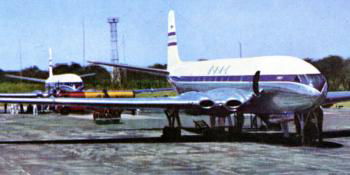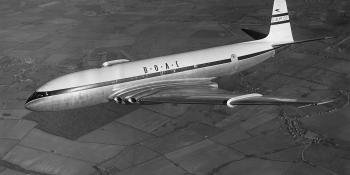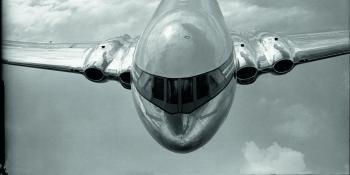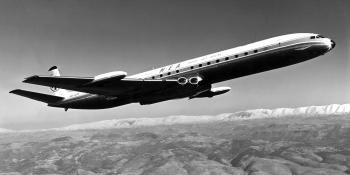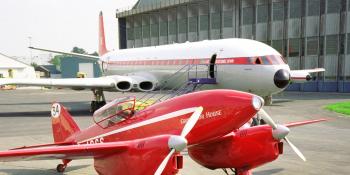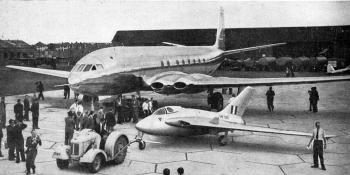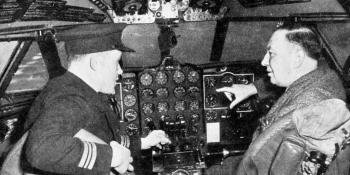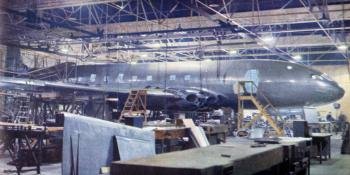de Havilland DH106 Comet
The de Havilland Aircraft Company created the renowned DH106 Comet which was revolutionary in being the first jet airliner. The maiden flight of the Comet took place on July 27, 1949. A number of crashes in airline service led the jetliner to be grounded for four years. A new variant, called the Comet 4, took to the air for the first time on April 27, 1958 incorporating all the recommended changes and also had a greater fuel capacity. The problems the Comet encountered meant it was the Boeing 707 and Douglas DC-8 which gained the majority of orders for early jetliners with only 114 of the British jet being produced.
The start of the new Elizabethan age brought with it one of Britain’s greatest aeronautical achievements: the inauguration of jet-powered airliner travel as opposed to the previous propeller-driven airliners. In comparison to these previous airliners, the de Havilland Comet offered a smooth and quiet jet flight. Other features of the jet included integral wing fuel tanks, low swept wings and power assisted flying controls.
Alas, the de Havilland Comet’s lead soon evaporated. Here's the story of its rise and fall
De Havilland Comet origins
For an event of such significance, it seemed a remarkably low-key affair. There was no fanfare of trumpets, just men in suits watching a government minister handing over a document. But it wasn’t any document, because it signified that the world’s first jet airliner was fit to fly fare-paying passengers. And start changing the world.
In January 1952 peace was only seven years old. Britain was still in the grip of post-war austerity and many items of food were rationed while others were in short supply. The accession to the throne of a new, young monarch helped bring some hope of better things to come. And so did the de Havilland DH106 Comet. As The Guardian observed decades later, the Comet “was a symbol of confidence and national recovery, a harbinger of future successes for British industry and enterprise in a new and hard world.”
Barely three months after being granted its certificate of airworthiness, the Comet launched the world’s first scheduled commercial services by jet airliner. It would be six years before the Americans caught up.
In 1952 the British aircraft industry was one of the world’s most powerful and influential. It wholeheartedly embraced the spirit of this new Elizabethan age. Almost daily, it seemed, an exciting prototype was being revealed or a new record set. Test pilots were household names. David Lean’s Sound Barrier, released in 1952, was one of the year’s most watched British films.
The fighters and bombers attracted most of the attention, but it was the civil aircraft which would have the greatest long-term significance. The elegant and graceful Comet was the first of many jets that would shrink the world and democratise air travel. It was, in hindsight, the start of a golden age for the industry.
In January 1952, Minister of Civil Aviation John Maclay visited de Havilland’s Hatfield factory to hand over the certificate of airworthiness, granted to the Comet by the Air Registration Board, to chief designer R. E. Bishop. Present were government and company bigwigs, including the permanent secretary to the Ministry of Civil Aviation and the ARB’s chief executive.
The Aeroplane, which published a picture of the hand-over in its issue of 1 February, noted that, considering this was a new type of aircraft, the ARB had been “rightly cautious in its assessment progress”. “It is good,” the journal observed, “that the travelling public should know that an entirely independent body has the final word in the all important matter of airworthiness.”
The Hatfield event marked the completion of a process that had begun during the Second World War, when the Brabazon Committees (see Aeroplane November-December 2020) were established to plan the equipment Britain’s airlines would need when peace returned and which would break into the American airliner building monopoly. Encouraged by the state-owned British Overseas Airways Corporation (British Overseas Airways Corporation), the de Havilland team transformed the basic Brabazon concept into a viable jet airliner. They did it under a veil of secrecy. Recalling a visit to de Havilland’s Hatfield plant in 1948, Peter Masefield, a key figure in post-war British aviation and then a senior government official, wrote, “What they were doing was so far ahead of the rest of the world that they were keeping the entire programme under wraps.”
Very little leaked out, but when it was finally revealed to the public the Comet turned out to have a less radical configuration than some had expected. However, it still bristled with innovative features in virtually every part of its aerodynamics, structure, propulsion and systems.
De Havilland Comet route proving
A key element of the certification process was route-proving and establishing the best way of operating the aircraft under a wide variety of conditions. This had begun when G-ALZK was delivered to BOAC’s Comet Unit at Hurn in April 1951. To see how the Comet fitted in with existing traffic patterns, 91 landings were made at 31 different overseas airports. Techniques of fuel economy were developed, and holding and descent patterns for a variety of airports like Beirut, Delhi, Singapore and Jakarta flown. Maintenance work was undertaken by BOAC engineers, assisted by manufacturer’s representatives when required. Simulated services to Johannesburg carrying freight instead of fare paying passengers began in January 1952. Three months later, the first of 10 Comet 1s was delivered to BOAC starting with G-ALYP (the first production aircraft). The last, ’YZ, arrived in September.
The crews also had to become familiar with the new aircraft. The first stage in crew conversion was a seven-week course at BOAC’s central training unit near Heathrow, following initial courses run by de Havilland at its own servicing school. Included in crew training was instruction on the engines, airframe and other aspects of the aircraft’s operation. At the end of the course, pilots and engineers had to pass the ARB’s examination to gain the necessary endorsement to operate as a crew member on passenger-carrying Comet flights. The exam took a day to complete and involved answering about 100 questions.
After that came the airline’s own training programme which involved four 90-minute sessions of circuits and landings, two at night and two during the day, as well a period of instrument flying. Familiarisation with the approach of compressibility, emergency descents using airbrakes and starting an engine after an in-flight flame-out were part of the syllabus.
Only when this portion of the training had been successfully completed were pilots signed off by the instructors. That enabled them to apply for a Comet licence endorsement at a cost of two guineas (£2.10). Even that did not end the training required to fly a Comet on revenue flights.
Route familiarisation represented the final stage. Captains were required to complete two full trips on any particular route before they could be authorised to fly in command. First officers also made two trips under supervision. The same was true for navigators, who had to demonstrate an ability to work fast and accurately.
In an article in The Aeroplane, BOAC chairman Sir Miles Thomas wrote that by May 1952 his Comet crews had accumulated around 1,000 hours on training and route familiarisation. The information gained, he said, would be “of tremendous value to subsequent users of jetliners.”
He also explained why the corporation had decided on Johannesburg as the destination for the first jet operations via intermediate stops. “The stage lengths accommodate the Comet 1 with generous margins and there is good traffic offering both end-to-end and in so far as the sectors are concerned”. Initially, he pointed out, Comet operations would arrive at Johannesburg via the airport at Palmietfontein pending completion of the Jan Smuts facility, although departures would be from the latter.
Thomas added, “The principle of running route familiarisation flights before opening the regular service has been of great value. We have learned much about high altitude weather conditions and found that many of the bogeys that were supposed to exist just didn’t happen.”
The Comet was opened up to a wider audience when the boys’ comic Eagle published a centrefold cutaway. This showed how the accommodation for 36 passengers was divided between two cabins seating eight and 28 respectively. Amenities included a drinking fountain, library, wardrobe and separate dressing rooms for ladies and gentlemen. What it didn’t show was that seat pitch was a generous 46in (117cm).
Fares were set accordingly. The single fare from London to Johannesburg was £175, while a round trip cost £315. At the time the average wage in Britain for a 42- hour week was £8.68 and an average house cost around £1,800.
The de Havilland Comet’s first commercial flight
For commercial aviation the jet age arrived at 15.12hrs on Friday 2 May 1952 when Capt A. M. Majendie, flight captain of BOAC’s Comet fleet, lifted G-ALYP off London Airport’s runway for the flight to Johannesburg. Before leaving Heathrow Majendie declared, “We are very glad to have the honour of launching this service. We are also very proud to be using this British aeroplane.”
The weather had been overcast, but a sudden burst of sunshine illuminated the historic moment of departure. A large crowd turned out to watch and there were comments about the thunderous noise made by the Comet on take-off.
The journey to Johannesburg took nearly a day. The actual flying time to cover the 7,000 miles (11,200km) was 23 hours 38 minutes, considered amazing by 1952 standards. The thirsty engines required en route replenishment halts at Rome, Beirut, Khartoum, Entebbe and Livingstone. The jet had to take on fresh crews at Beirut and Khartoum.
Majendie had expected headwinds on the first leg and, indeed, the Comet was nine minutes late when it landed in Rome at 16.46hrs. Time was made up on the stage to Beirut and a tailwind helped the aircraft average 525mph (840km/h). Later in the flight, Capt R. C. ‘Cliff ’ Alabaster actually had time to spare. Because the airline considered it essential to adhere to the published schedules, he was required to leave Livingstone late and make wide turns.
When the Comet arrived at Johannesburg, a reported 20,000 spectators were waiting to catch their first sight of the new jet. It arrived two minutes ahead of schedule and the passengers were said to be “without the slightest sign of fatigue”. Each one later received a special certificate. The following Monday the aircraft left for home and arrived just under 24 hours later.
“It went without a hitch”, declared BOAC’s chairman, who had joined the aircraft at Livingstone. The flight, he added, had “put British aviation — jet-propelled — on the map of the world.”
Royals on the de Havilland Comet Jet Airliner
Less than a month later, the Queen Mother and Princess Margaret became the first members of the Royal Family to sample the new aircraft. Although organised by the manufacturer, BOAC had loaned G-ALYR to de Havilland for the special flight. The aircraft took off from Hatfield at 12.25hrs on 2 June and, after flying a route which took it as far south as Turin, touched down at 16.25. It had cruised at 40,000ft (12,300m) and recorded an average speed of 462mph (740km/h). It seemed the Queen Mother had for some time been keen to fly in the Comet. Afterwards she said it “was a lot faster than the aircraft of the King’s Flight”. This was a reference to the Vickers Viking, whose cruising speed was about half that of the jet’s.
In June BOAC increased the frequency of round-trip Comet flights between London and Johannesburg to three a week. It launched a weekly return service to Colombo in August and, two months later, a weekly service to Singapore. That frequency was soon increased to two. The following year Tokyo was added to the schedules.
Seven decades later it’s hard to overstate the Comet’s impact. US designs like the Lockheed Constellation and the Douglas DC series seemed to be the acme of piston-engined airliners. But here was the Comet offering a 200mph (320km/h) hike in cruising speed. It was, aviation historian R. E. G. Davies observed, “a greater incremental leap forward than had been achieved by the previous three airliner generations during two decades”. The Aeroplane, which published a special issue dated 2 May, commented, “The coming of the Comet has changed the travelling habits of the globe as much as the coming of the Rocket sounded the knell of the long distance horse-drawn coach.”
Another seasoned observer was Peter Masefield, who had been secretary to the Brabazon Committees, British air attaché in Washington and would become managing director of British European Airways. To him the Comet represented “a really bold step forward”. In his autobiography he wrote, “To me it was astonishing that such competitive companies as Lockheed and Douglas, with far more design engineers than any British aircraft company, were showing no interest whatsoever in building a viable civil transport with jet engines.”
That wasn’t entirely true. Boeing, whose products would later dominate the world market for jet airliners, was certainly impressed by the Comet but decided to wait and watch developments before committing itself to jets. Besides, it had its hands full with bombers. The six-jet B-47 was entering service with the US Air Force’s Strategic Air Command, and the eight-jet YB-52 prototype made its first flight in August 1952. Lockheed and Douglas were even more relaxed.
By the late summer of 1952 Britain had three turbine-powered airliners flying — four if you included the doomed Princess — with three different turbine engines. By 1953, two of these types would be in regular passenger service, well ahead of anything the Americans or anybody else could manage.
Why did de Havilland Comets keep crashing
But then some of the glitter started to wear off. The jet age was barely two years old when two Comets exploded over the Mediterranean with the loss of all on board. The fleet was grounded. There had been previous Comet crashes, but they had been attributed to bad weather or pilot error. The subsequent investigation set new standards for thoroughness and eventually traced the cause to metal fatigue, about which comparatively little had been known. But British prestige had taken a big hit.
With commendable determination, de Havilland set about producing the revised Comet 4, which in 1958 operated the world’s first trans-Atlantic jet passenger service. Its swiftness in getting the Comet 4 into use contrasted with the sluggishness displayed by Bristol in developing the Britannia.
Meanwhile, the Boeing 707 and Douglas DC-8 were preparing to go into service.
By Bruce Hales-Dutton
